Wedding Traditions Around the World: Exploring Diverse Practices Amidst Globalisation
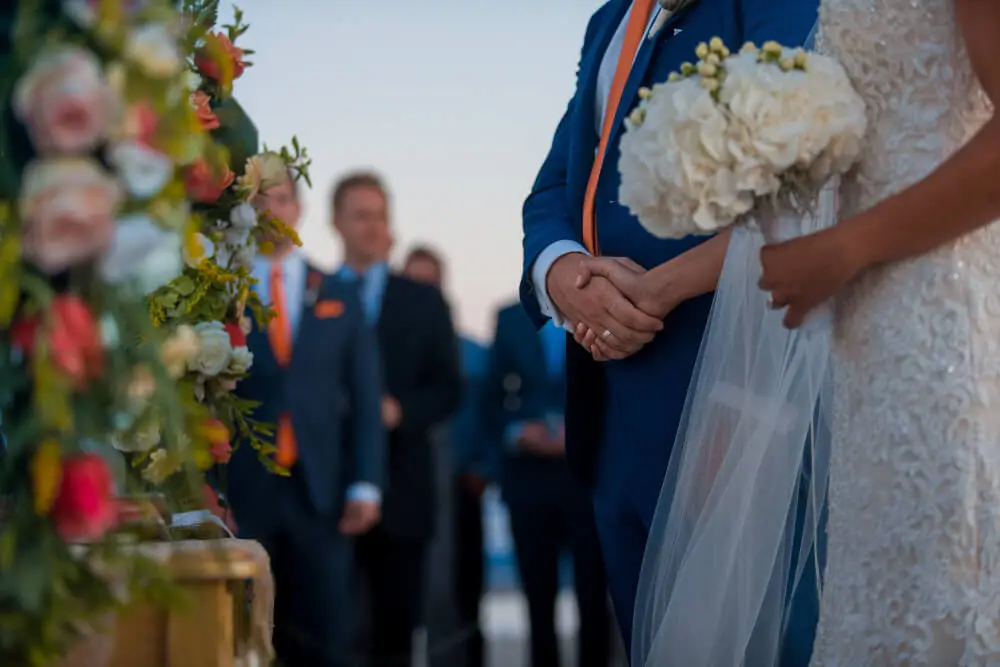
Updated On: April 21, 2024 by Yasmin Elwan
As the world becomes increasingly interconnected, the traditions and practices of weddings continue to reflect the beautiful tapestry of human culture. Across the globe, from the bustling streets of India to the serene countryside of Norway, matrimonial ceremonies are not just a union of two individuals but also a celebration of cultural heritage and familial ties. Despite the advances of globalisation, these traditions remain deeply rooted in the identities of people everywhere, often evolving yet retaining their core significance.
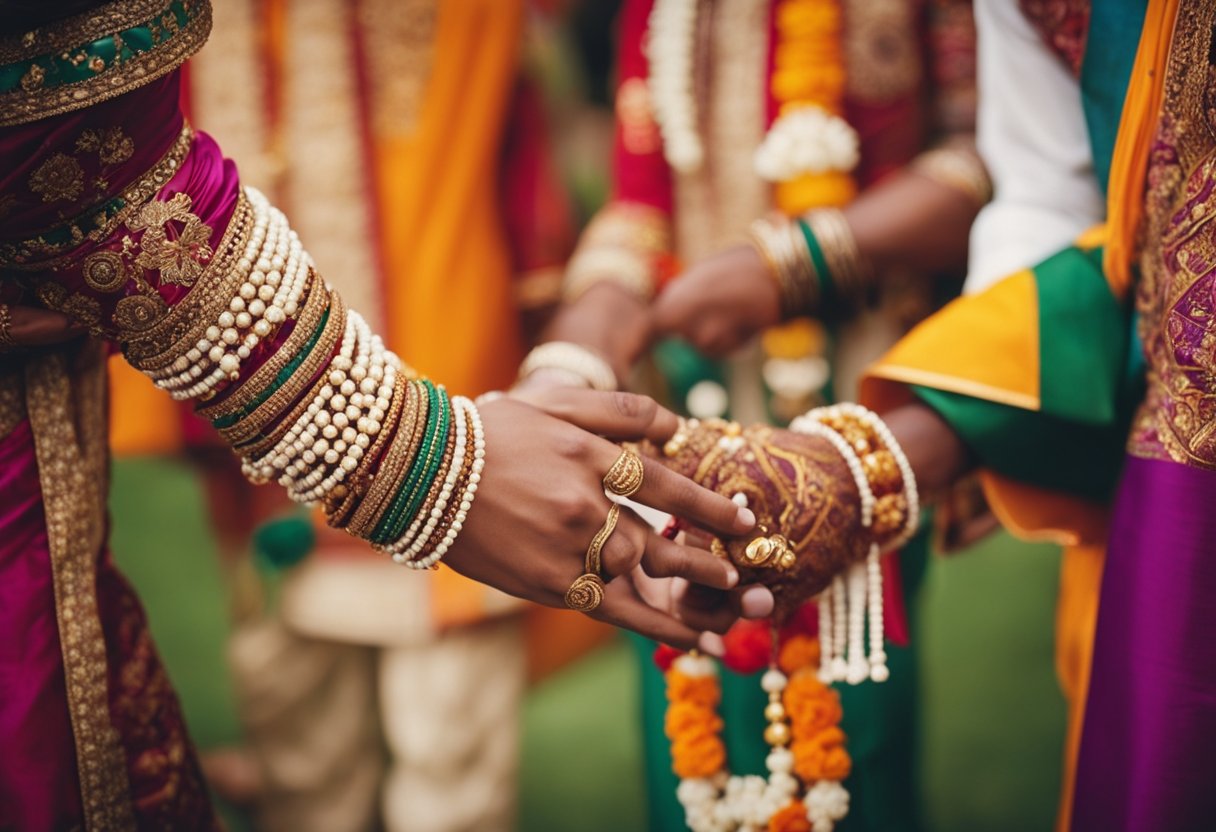
In the age of globalisation, cross-cultural exchange has introduced a vibrant array of customs into the wedding scene. African celebrations brim with joy, incorporating centuries-old rituals that honour ancestry and community. Meanwhile, American weddings often blend the formal with the personal, while European vows span a spectrum from the quaint countryside to grand cathedrals. Across Asia, weddings display an intricate blend of old-world customs and modern sensibilities, ushering in a future where traditional rituals meet the aspiration for novelty and personalisation.
Grasping Global Wedding Rituals
As we uncover the variety of wedding traditions from different cultures, it becomes clear that the customs and rituals of marriage are as diverse as the people celebrating them. These traditions reflect not only a couple’s commitment but also their family and community ties.
Traditional Vows and Unions
In the realm of traditional vows and unions, the words spoken by couples often pay homage to their heritage and forebearers. In England, for instance, the classic phrase “to have and to hold” has been part of the marriage vows for centuries. However, many cultures have their own unique pledges. For example, in India, the Saptapadi, or seven steps, is a crucial part of the ceremony, with each step representing a different aspect of life that the couple will share together. These steps, often taken around a sacred fire, symbolise nourishment, strength, prosperity, happiness, progeny, longevity, and harmony.
In Japan, the San-San-Kudo ceremony involves the sharing of sake between the couple, symbolising the union and the bonding of their families. The ritual of sharing a drink signifies a promise between the couple and their families, fortifying bonds with each sip.
Diverse Marriage Customs
Delving into more diverse marriage customs, one finds fascinating practices that illuminate the values of the community. Armenian weddings often incorporate the balance of lavash flatbread on the shoulders, which represents prosperity and peace for the new couple. The bread balances on their shoulders as they dance into their reception, suggesting the shared responsibilities they will carry forward.
Similarly, in Greece, the groom receives a shave from the koumbaro, or best man, which is a gesture of trust and brotherhood before stepping into marital life. Across the world, these diverse customs and rituals, from the lavish procession of an Indian wedding to the subtle intricacies of a Japanese ceremony, showcase the global tapestry of marriage traditions. Each custom narrates a story, contributing to a larger narrative of unity and communal ties, as seen in The Knot’s exploration of favourite wedding traditions.
Cultural Celebrations in Africa
Weddings across the African continent are a tapestry of tradition and cultural vibrancy. Each ceremony is a unique blend of customs that reflect the rich heritage of the region.
Vibrant West African Ceremonies
In West Africa, nuptials are often characterised by elaborate festivities. Ghana, for instance, is renowned for its ‘Knocking Ceremony’. Before a wedding can proceed, the groom must symbolically ‘knock on the door’ of the bride’s family’s home to ask for her hand in marriage. This ritual cements the union between the two families. Traditional attire, often made from colourful kente cloth, is a common sight at such ceremonies, symbolising the couple’s pride in their heritage and bringing good luck to their marriage.
Henna and Happiness in North Africa
Moving to North Africa, the henna ceremony is a quintessential pre-wedding ritual, particularly in nations like Algeria and Morocco. It is a moment where the bride, adorned with intricate henna designs, celebrates her impending nuptials surrounded by female relatives and friends. These designs are not just for beauty; they are symbolically placed to bring good luck and blessings to the couple. This festive occasion showcases the region’s dedication to blending beauty with tradition, creating a rich tapestry of cultural celebration that carries forward into the wedding ceremony itself.
American Matrimony: Rituals and Receptions
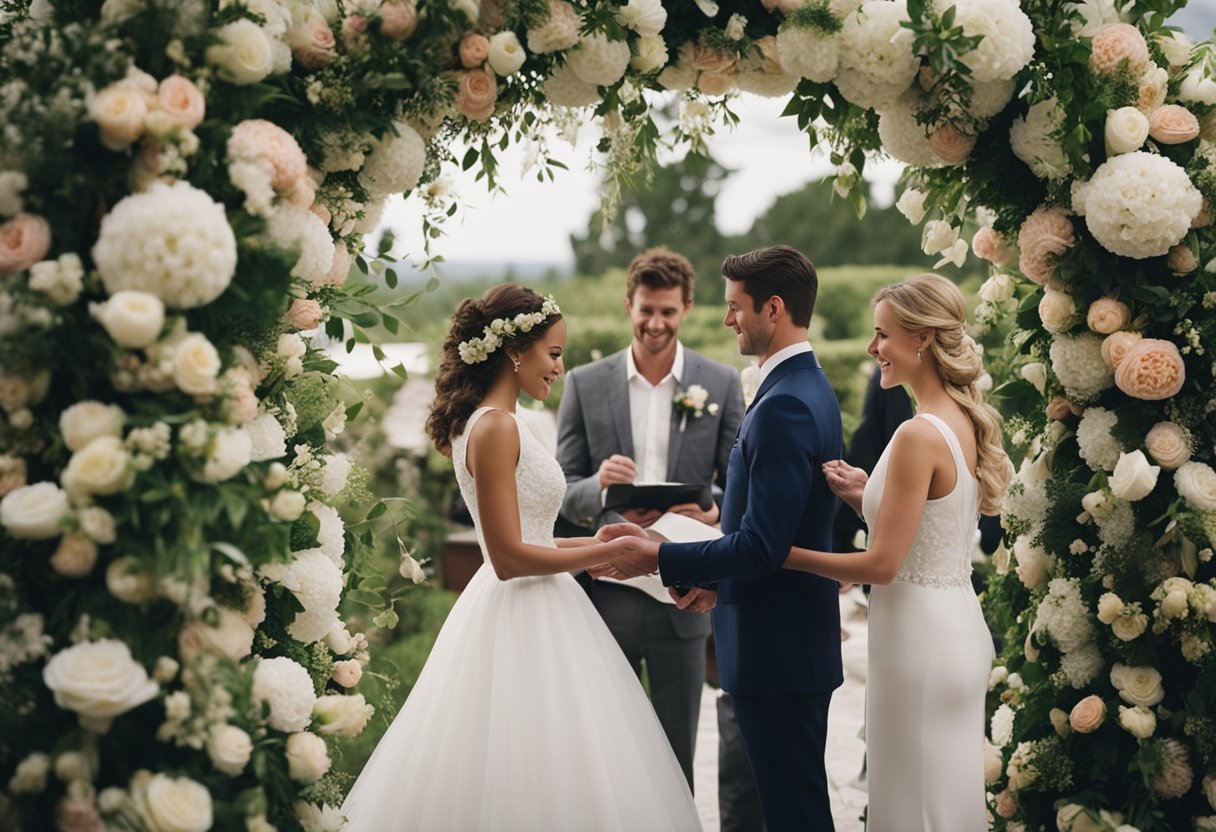
In the landscape of American nuptials, we observe a fusion of time-honoured customs with contemporary creativity. Our journey through these rituals shows both a reverence for tradition and a penchant for personalisation.
American Ingenuity in Wedding Practices
As we explore American wedding customs, we find a blend of the conventional with the innovative. Traditionally, American brides wear a wedding veil and carry “something old” to symbolise continuity. A newer practice involves personalising the reception space to reflect the couple’s unique story.
From jumping the broom—a tradition borrowed from African heritage symbolising the sweeping away of the old and welcoming the new—to the lavish receptions that often feature various forms of entertainment and cuisine, the adaptability of American practices shines through. The act of throwing rice or other items as a symbol of fertility and prosperity has been modified in some modern weddings to include alternatives like bubbles or even sparklers.
Latin American Influence on Nuptials
The influence of Latin American culture on American weddings is unmistakable, especially in rituals like the lazo and arras. The lazo, a ceremonial rope, is placed around the couple to signify unity, while the arras consists of 13 coins exchanged to symbolise wealth and shared financial responsibility.
These customs, integrated into weddings across America, showcase the rich blend of cultures that shape American society. We witness receptions enlivened with Latino music and dance, further exemplifying the beautiful amalgamation present within American matrimony.
Asian Perspectives on Matrimony
In Asia, marriage is not just a bond between two individuals but an intricate tapestry woven from age-old customs and communal ties. It’s an institution that respects tradition, honours family, and cherishes the cultural rituals passed down through generations.
Sacred Japanese Ceremonies
In Japan, the traditional Shinto wedding honours the kami, or spirits, and features rituals that have been carried out for centuries. The ceremony often takes place at a Shinto shrine, with the bride typically adorned in a pure white kimono, symbolising purity.
This garment, called a shiromuku, is complemented by an elaborate headpiece that covers the bun, symbolising obedience to the groom. The ritual of san-san-kudo is central in the ceremony; both bride and groom take three sips each from three flat sake cups, signifying a formal bond between the families. This exchange illustrates a commitment to mutual support and the absence of selfishness.
Chinese Tea and Togetherness
In China, the tea ceremony is a quintessential component of wedding celebrations, emphasising respect and the joining of families. The traditional wedding begins with the couple serving tea to their parents and elders as an expression of gratitude and reverence. It’s a poignant moment that underscores the importance of filial piety in Chinese culture.
During the ceremony, the bride often wears a red dress, known as a qipao, which is a symbol of luck and happiness. The tea itself represents fertility and prosperity, ensuring that the newlyweds embark on their lives together, blessed with good fortune. As the photographs are taken—capturing smiles in red and gold attire—the air buzzes with joy and the anticipation of prosperous years to follow.
European Nuptials from East to West
In the rich tapestry of European wedding traditions, the customs vary widely from the sun-kissed Italian coast to the deep forests of Sweden. As we traverse from east to west, we find a kaleidoscope of cultural rituals that have both endured and adapted in the age of globalisation.
From Italy’s Old to Something New
In Italy, the azure hues of the Mediterranean inspire the tradition of ‘something blue’, a practice that has mingled with the global ‘something new, something borrowed, something blue’ axiom. The Italian spin involves incorporating a blue garter or piece of fabric into the bridal attire. It’s a nod to fidelity and love, as timeless as the ancient Roman roots and as vibrant as a Venetian carnival.
La bustarella, a custom akin to the ‘money dance’ found also in Venezuela, sees guests gifting money to the couple in envelopes. This gesture helps the newlyweds start their life with a nest egg while reinforcing community bonds.
Vibrant Balkan Festivities
Moving to the Balkans, one is enveloped in the heart-pounding rhythms of traditional music and dance. Weddings here are famed for their exuberance, where a celebration isn’t complete without a full orchestration of local ties in the form of festivities that can last for days.
For instance, in Greece, the role of the koumbaro—the best man—is integral. He leads the couple in the ceremonial ‘dance of Isaiah’, bestowing his blessings and showing the unity of the community in supporting the couple.
The bonding over food is just as important, with the cake pull offering a playful prediction of who might be the next to marry; similar traditions can be found across Europe, from Germany’s polterabend, where guests break porcelain for good luck, to the Russian bread and salt welcome for the newlyweds.
In these European celebrations, the dance between cherished traditions and innovative additions creates a wedding mosaic as complex and beautiful as the continent itself.
Rituals and Festivities Across India
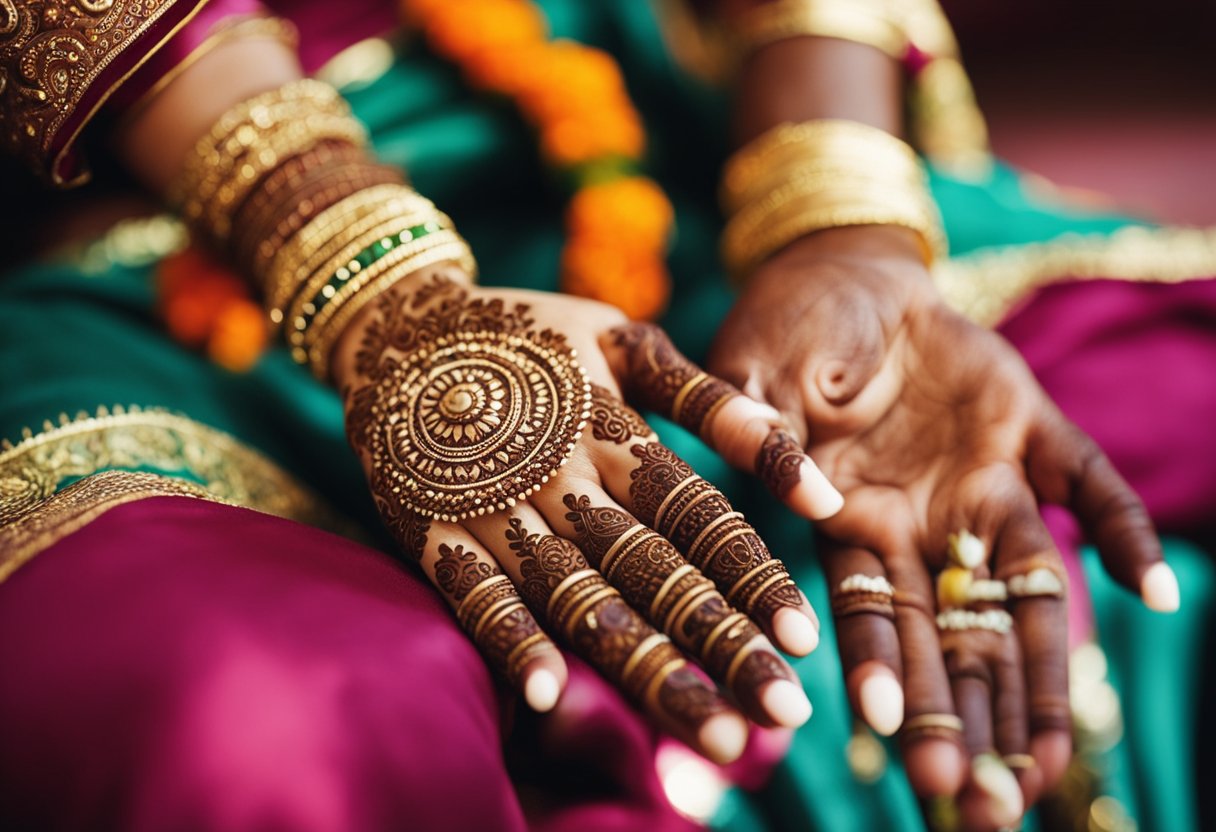
As we explore the vibrant wedding traditions of India, we’re immersed in a tapestry of rituals that are both colourful and deeply symbolic. The subcontinent’s rich heritage manifests in diverse ways from North to South.
North Indian Baraats and Mehndi
In the flamboyant North Indian weddings, the baraat is a procession like no other. The groom, traditionally atop a horse, is accompanied by family members, friends, and a band playing traditional music. It’s a celebratory display that heralds the auspicious union to come. Commensality is central in these events, with guests and families sharing food as a means of social connection.
The Mehndi ceremony closely follows festivity. Here, henna is applied to the bride’s hands and feet in intricate patterns, often with hidden groom initials. The practice is said to bring good luck and signify the strength of love, making Mehndi a cherished pre-wedding ritual.
South Indian Sarees and Symbolism
Venturing to the South, the traditions embrace a more solemn but equally rich cadence. Brides in this region are often seen in elegant, gold-bordered sarees. The saree, beyond being a mere garment, symbolises grace and cultural pride. The ceremony is replete with symbolic acts, like the tying of the ‘Thaali’, a necklace that represents marital vows and lifelong commitment.
Each aspect of a South Indian wedding is a deliberate celebration of familial bonds and cultural heritage, from the exchanging of floral garlands, symbolising acceptance of one another, to the giving of dowries – a practice that has evolved but is rooted in historical exchanges between families. The air at these weddings is heavy with the scent of jasmine and incense, which, alongside the melodies of Carnatic music, completes the sensory experience.
Throughout India, weddings are not just the union of two people but a declaration of family ties and a tribute to traditions that have been cherished for centuries.
Symbolic Wedlock Elements and Their Meanings
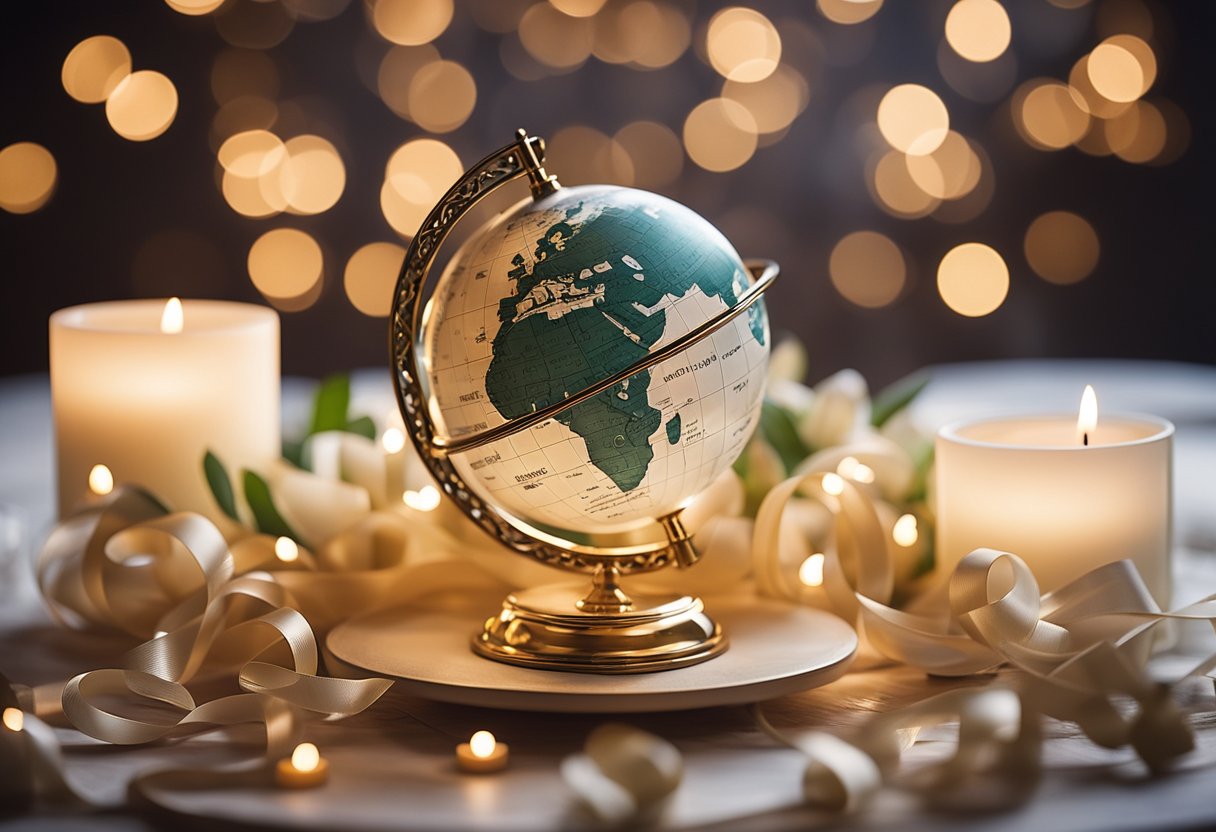
In this section, we explore the vivid tapestry of symbolic elements in weddings that articulate the essence of cultural richness and the time-honoured significance of matrimony.
Rings, Garments, and More
Wedding traditions are adorned with an array of elements that hold profound symbolism and cultural significance. One universal symbol, the wedding ring, embodies an unbroken circle that represents eternal love and commitment. It is an emblem that, across cultures, speaks of the union that wedding vows bring into being.
The wedding veil and white wedding dress are traditionally seen as symbols of purity and innocence. In many cultures, the veil guards the bride’s modesty and, in some interpretations, protects against evil spirits. The white hue of a bridal gown has been popularised as a representation of purity, although in some cultures, other colours are chosen to convey different meanings, such as red for luck and prosperity in Asian traditions.
Ritualistic Significance of Wedding Elements
Wedding ceremonies, regardless of their locale, are steeped in ritualistic practices that reinforce the gravity of the matrimonial bond. The exchange of vows is a quintessential act where couples pronounce their commitment before witnesses, invoking a promise that is as much personal as it is societal.
Cultural rituals also bestow additional layers of meaning upon wedding elements. For instance, breaking a plate for good luck in some cultural wedding receptions bridges the old with the new, asserting a hopeful future together. Whether it’s the cloaking of a groom in lavash and honey for prosperity or the signing of a Ketubah in Jewish weddings, which is a marital document detailing mutual respect and responsibilities, these traditions continue to be cherished and adapted in contemporary ceremonies.
The global wedding landscape remains a vibrant mosaic where each thread—a ritual, a garment, a spoken vow—contributes to the enduring allure of wedlock traditions, constantly woven with the threads of the past while embracing the promise of tomorrow.
Contemporary Weddings and Global Influences
In today’s interconnected world, wedding ceremonies are becoming a fusion of traditions, reflecting both the breadth of global influences and a deep respect for cultural heritage.
Blending Traditions in Modern Ceremonies
We’ve observed a surge in couples incorporating elements from various cultures into their own weddings. It’s not just about the aesthetics; it’s a celebration of their unique, intertwined cultural identities. For instance, it’s increasingly common to see a Japanese sake-sharing ritual complement the classic exchange of wedding rings, symbolising the union with respect to both partners’ heritages. The act of blending traditions embodies respect for the past while navigating the shared journey of a globalised community.
Western-Style Weddings’ Growing Appeal
The allure of Western-style weddings has spread globally, often emblematic of a modern, chic celebration of love. Many couples are drawn to the classic white wedding gown, the tiered cake, and the first dance. This widespread admiration goes beyond cultural boundaries and speaks to the power of Western media in shaping perceptions of what a wedding should look like. Yet, we see that these Western elements are adapted and woven into the local context, respecting religious and cultural norms while embracing a globalised view of matrimony.
Celebratory Customs Around the Globe
In various corners of the world, wedding celebrations are marked by distinctive customs that often involve spirited dancing and drumming, as well as the exchange of meaningful gifts. These practices are not only expressions of joy but also of gratitude, reflecting the cultural values and traditions of each society.
Joyous Dance and Music Keynotes
In Cuba, the money dance is a vibrant custom where every gentleman who dances with the bride can pin money onto her dress as a token of good fortune and support. This practice is a blend of celebration and generosity, honouring the new couple as they embark on their life together. In American weddings, a similar concept exists, often involving upbeat music and jovial dancing, but instead of pinning money, guests might slip cash to the couple as a gift.
Feasts and Gifts as Acts of Gratitude
At German wedding receptions, it’s common for guests to bring porcelain items that are smashed during the party. This tradition, Polterabend, is believed to bring luck to the couple’s marriage. After the smashing of porcelain, a communal clean-up takes place, symbolising that by working together, the couple can face any challenge. The feast that follows typically features hearty dishes, and the sharing of food serves as a powerful symbol of community and gratitude.
In these various traditions—whether it’s the elegance of a bride’s graceful steps at a Norwegian wedding or the convivial laughter that fills the air during a German Polterabend—the joyous pulse of the drums, the clinking of glasses, and the heartfelt exchange of gifts remain consistent as hallmarks of the global language of wedding celebrations.
Secular Elements in Traditional Weddings
In traditional weddings, amidst the rich tapestry of rituals, a stream of secular elements has permeated ceremonies, reflecting our globalised society’s evolving values. These elements, often non-religious in nature, offer a contemporary twist to age-old practices.
Civil Ceremonies Worldwide
In various parts of the world, couples are opting for civil ceremonies as an alternative to religious rituals, celebrating their union in a way that is non-denominational and often more flexible in terms of location and content.
The bouquet toss and garter toss, long-standing traditions in Western weddings, are examples of customs that can be incorporated into these secular festivities, symbolising good fortune and playfulness rather than religious ideals. Civil ceremonies empower couples to craft bespoke nuptials that may incorporate elements of nature and spirituality without adhering strictly to religious doctrines.
Nature and Spirituality in Wedlock
The reverence of nature has become a central theme in modern weddings, honouring the earth and its elements as intrinsic aspects of the celebration. Some couples imbue their special day with rituals that reflect a deep spirituality unaffiliated with a specific faith.
For instance, in some Jewish weddings, the traditional chuppah has evolved beyond its religious significance, serving as a symbol of the home being built by the couple under the canopy of the sky. Elements of nature such as spectacular settings – forest clearings or cliff-top panoramas – become altar-like spaces, offering a sense of the sacred that is at once inclusive and universal, satisfying a yearning for connection and a sense of belonging to something greater.
Frequently Asked Questions
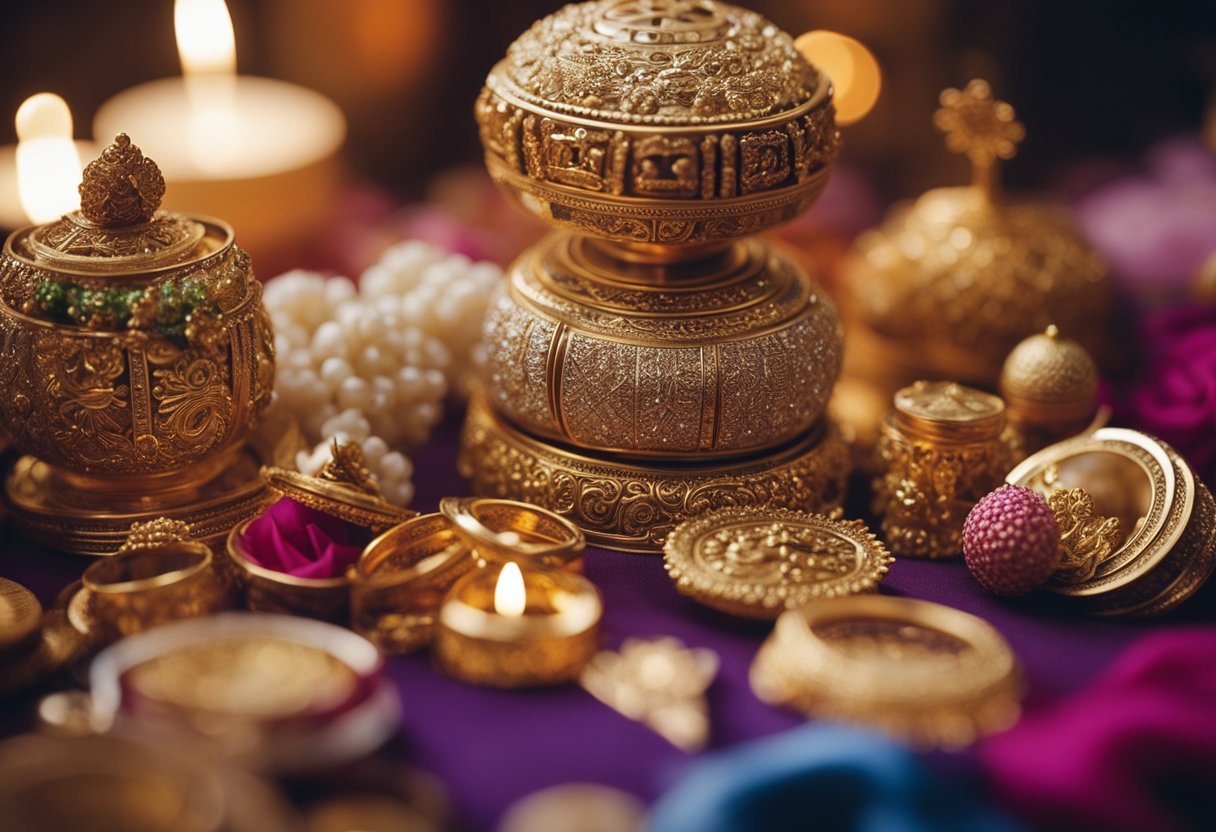
In the realm of weddings, global influences have woven into local traditions, creating a tapestry of customs that blend the ancient with the modern. We navigate these waters, answering queries about the time-honoured rituals and the fresh practices that define marriage ceremonies worldwide.
What are some wedding traditions that have been adopted globally due to modernisation?
Many weddings now commonly feature exchanges of rings, which symbolise unity and eternity, and the white bridal gown, indicative of purity, both of Western origin. The reception, a collective celebration with food, music, and dancing, has also become a staple across various cultures.
How have different cultures influenced contemporary wedding ceremonies?
Contemporary weddings often embrace a melange of global traditions, such as the vibrant henna tattoos from South Asian ceremonies or the Jewish custom of breaking glass to remember life’s fragility. These are examples of how diverse customs have permeated various cultures, creating enriched ceremonial experiences.
Which ancient wedding customs are still practised today?
Couples across the globe continue to honour age-old customs, like the Chinese tea ceremony as a sign of respect, or the lively money dance found in Filipino and Polish traditions. These practices are imbued with respect for heritage and familial bonds, surviving the test of time.
In what ways have marriage ceremonies evolved from the Middle Ages through to the Renaissance?
During the Middle Ages, marriages were often utilitarian, but by the Renaissance, ceremonies began to embody more romance and personal choice. Dowries evolved into exchanges of love tokens, and public celebrations became more elaborate to symbolise social status.
Can you identify unique marriage practices that have emerged in different cultures as a result of globalisation?
As cultures intermingle, unique marriage practices arise, such as the fusion of different religious rites or the incorporation of international themes into decor and attire. For instance, the Indian sangeet has inspired pre-wedding events in cultures that traditionally did not have such celebrations.
What is the origin of various customary wedding rituals that are celebrated internationally?
Many wedding rituals celebrated internationally have deep roots. For example, the bouquet toss is thought to have originated in England as a means for the bride to pass on her good fortune, while the elaborate Japanese ceremony of san-san-kudo involves sharing sake to symbolise the union of families.






